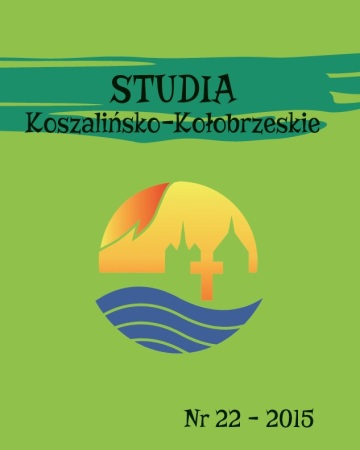
ISSN: 1230-0780
eISSN: 2719-4337
OAI
DOI: 10.18276/skk.2015.22-08





Issue archive /
nr 22 2015
Zbawczy charakter misterium Bożego Narodzenia. Próba prezentacji dynamicznej wizji wcielenia
(Salvific character of the mystery of Christmas. An attempt to present the dynamic vision of incarnation)
| Authors: |
Bogdan
Kulik
Wyższe Seminarium Duchowne Misjonarzy Świętej Rodziny w Kazimierzu Biskupim |
| Keywords: | Jesus Christ Incarnation Salvation Redemption |
| Data publikacji całości: | 2015 |
| Page range: | 16 (115-130) |
Abstract
Although the work of salvation of man by Jesus Christ reached its climax in His passion, death and resurrection, it began on the reception of human nature by the Son of God. It is witnessedin the Holy Scripture and Tradition which teach that the main objective of the salvific action is to liberate the man from sin and restore him to the fullness of life. Since the destructive powerof sin reveals itself in: 1) breaking off the relationships with God, 2) death, 3) a loss of the meaning of life. These three specific consequences of sin relates to the salvific action of God inthe act of the Incarnation. Salvation has got a dual aspect: it is bestowing the good (the positive aspect) and liberating from the evil (the negative aspect). As a result, the Incarnation of theSon of God includes: 1) offering one’s presence and liberating from loneliness, 2) offering life and liberating from death, 3) offering hope and liberating from meaninglessness. Christmasis the right moment to spread this truth. This celebration ought to be a special occasion to reflect deeply upon the mystery of the liberating meeting of man with God in the newly-bornEmmanuel.
Download file
Article file
Bibliography
| 1. | Athanasius, To Epictetus, http://www.ccel.org/ccel/schaff/npnf204.xxv.iii.iv.xiv.html. |
| 2. | Augustyn, Kazanie 185. Na Dzień Narodzenia Pana, 2, w: Tenże, Wybór mów. Kazania świąteczne i okolicznościowe, red. E. Stanula, Warszawa 1973. |
| 3. | Bujak J., „On jest obrazem Boga niewidzialnego” (Kol 1, 15). Wprowadzenie do chrystologii, Szczecin 2011. |
| 4. | Enchiridion symbolorum, definitionum et declarationum de rebus fidei et morum, red. H. Denzinger – P. Hünermann, Bologna 20095. |
| 5. | Hipolit, Przeciw Noetosowi, w: Trójca Święta. Tertulian. Przeciw Prakseaszowi. Hipolit. Przeciw Noetosowi, red. H. Pietras, Kraków 1997. |
| 6. | Ireneusz, Adversus haereses, III, 18, 1. 7, w: Ireneusz, Chwałą Boga żyjący człowiek, red. J. Comby, D. Singles, Kraków 1999. |
| 7. | Jan Paweł II, Encyklika Redemptoris missio (07.12.1990). |
| 8. | Katechizm Kościoła Katolickiego, Poznań 1994. |
| 9. | Kongregacji Nauki Wiary, Dominus Iesus. Deklaracja o jedyności i powszechności zbawczej Jezusa Chrystusa i Kościoła, (06.08.2000). |
| 10. | Leon Wielki, Kazanie na Uroczystość Narodzenia Pańskiego, 1; w: Tenże, Kazania wybrane, red. J. Czuj, Poznań 1936. |
| 11. | Marcel G., Il mistero dell’essere, Roma, 19872. |
| 12. | Moysa S., Zbawienie, w: Katolicyzm A-Z, red. Z. Pawlak, Poznań 1994, s. 397-398. |
| 13. | Naumowicz J., Wcielenie Boga i zbawienie człowieka. Złota reguła soteriologii patrystycznej, „Warszawskie Studia Teologiczne” 13(2000), s. 17-30. |
| 14. | O’Collins G., Cristologia. Uno studio biblico, storico e sistematico su Gesù Cristo, Brescia 19922. |
| 15. | O’Collins G., Gesù nostro Redentore. La via cristiana alla salvezza, Brescia 2009. |
| 16. | O’Collins G., Incarnazione, Brescia 2004. |
| 17. | Paluch M., Traktat o zbawieniu, Warszawa 2006. |
| 18. | Proklus, Kazanie 7 na Objawienie Pańskie, 1-3, w: Liturgia Godzin. Codzienna Modlitwa Ludu Bożego, tom 1, Poznań 1982, s. 524-526. |
| 19. | Proklus, Kazanie ku czci Najświętszej Dziewicy, 2, w: Ojcowie Kościoła greccy i syryjscy. Teksty o Matce Bożej, red. W. Kania, Niepokalanów 1981. |
| 20. | Propitiatorium w: A. Jougan, Słownik kościelny łacińsko-polski, Warszawa 19924, s. 549. |
| 21. | Rahner K., Natale, festa dell’eterna giovinezza, w: Nuovni saggi II, Roma 1968, s. 151-152. |
| 22. | Rahner K., Notte di Natale, w: Nuoni saggi II, Roma 1968, s. 159-164. |
| 23. | Rahner K., Problemi della cristologia d’oggi, w: Saggi di cristologia e di mariologia, Roma 1965, s. 3-91. |
| 24. | Rahner K., Il significato perenne dell’umanità di Gesù nel nostro raporto con Dio, w: Saggi di cristologia e di mariologia, Roma 1965, s. 240-258. |
| 25. | Rahner K., Teologia dell’incarnazione, w: Saggi di cristologia e di mariologia, Roma 1965, s. 93-121. |
| 26. | Ratzinger J., Przyszłość zbawienia, w: Zmartwychwstanie i życie wieczne. Studia o eschatologii i teologii nadziei, Lublin 2014, s. 459-478. |
| 27. | Ratzinger J., Zmartwychwstanie ciał, w: Zmartwychwstanie i życie wieczne. Studia o eschatologii i teologii nadziei, Lublin 2014, s. 332-337. |
| 28. | Rusecki M., Cud w chrześcijaństwie, Lublin 1996. |
| 29. | Rusecki M., Funkcje cudu, Sandomierz–Lublin 1997. |
| 30. | Winling R., Natale e il mistero dell’incarnazione, Brescia 2013. |
| 31. | Zawadzki R., Jezus jako gō’ēl. Przyczynek do chrystologii Nowego Testamentu, „Perspectiva. Legnickie Studia Teologiczno-Historyczne” 8(2009), nr 2, z. 15, s. 254-269. |
| 32. | Sobór Watykański II, Konstytucja o liturgii świętej, w: Sobór Watykański II. Konstytucje-Dekrety-Deklaracje, Poznań 1967. |